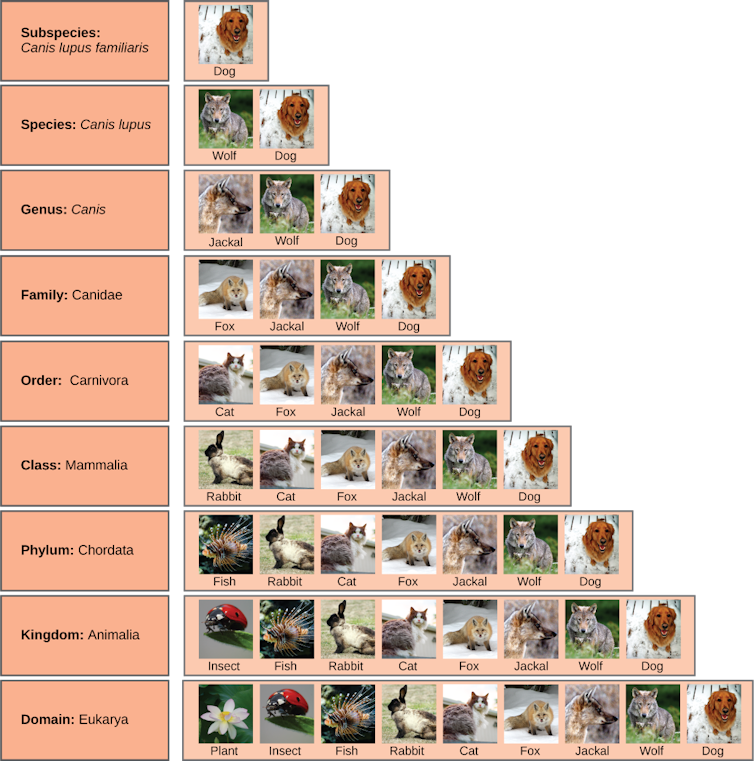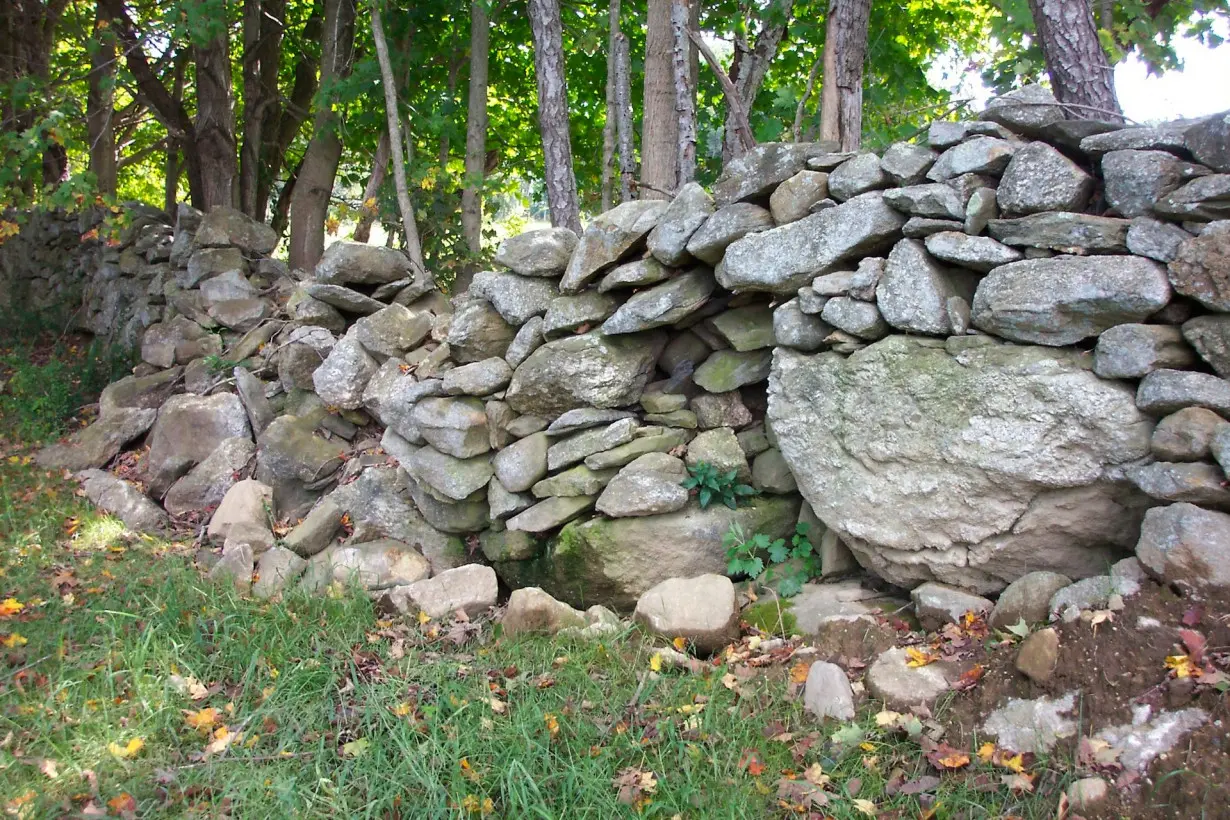The abandoned fieldstone walls of New England are every bit as iconic to the region as lobster pots, town greens, sap buckets and fall foliage. They seem to be everywhere – a latticework of dry, lichen-crusted stone ridges separating a patchwork of otherwise moist soils.
Stone walls can be found here and there in other states, but only in New England are they nearly ubiquitous. That’s due to a regionally unique combination of hard crystalline bedrock, glacial soils and farms with patchworks of small land parcels.
Nearly all were built by European settlers and their draft animals, who scuttled glacial stones from agricultural fields and pastures outward to fencelines and boundaries, then tossed or stacked them as lines. Though the oldest walls date to 1607, most were built in the agrarian century between the American Revolution and the cultural shift toward cities and industry after the Civil War.
The mass of stone that farmers moved in that century staggers the mind – an estimated 240,000 miles (400,000 kilometers) of barricades, most stacked thigh-high and similarly wide. That’s long enough to wrap our planet 10 times at the equator, or to reach the Moon on its closest approach to Earth.
Natural scientists have been working to quantify this phenomenon, which is larger in volume than the Great Wall of China, Hadrian’s Wall in Britain and the Egyptian pyramids at Giza combined. This work began in 1870 and generated the U.S. government’s 1872 Census of Fences. Today, scientists are using a technique called LiDAR, or light detection and ranging, to measure and map stone walls across New England.
Being a geologist, I’m interested in walls as landforms that are distinctive to the region, created during the lead-up to the Anthropocene epoch – a time when human agency dominates all others. I’ve written about the history of stone walls and how to interpret them in the field, and developed the Stone Wall Initiative to draw public attention to their importance in New England. Now, I’m working with students and colleagues to develop a formal interdisciplinary science of stone walls that will help researchers understand and preserve them.
Dens and pathways
My brother-in-law enjoys his backyard wall in Lee, New Hampshire, mainly for its aesthetic, historic and literary ambiance. The wild things living in his neighborhood depend on it as unique habitat.
To lichens and moss, the wall’s dry stones are surfaces where plants can’t compete. For plants, such walls are edges that separate patches of ground into zones that are sunny or shady, windward or leeward, uphill or downhill, wetter or drier. Stone walls offer small mammals porous volumes in which to live their furtive lives. Predators use the walls as hunting blinds and travel corridors.
Just for fun, my brother-in-law installed a motion-activated, infrared video camera on his backyard wall to see who was using the wall and how. On June 21, 2023, the summer solstice, he filmed a bobcat (Lynx rufus) hiding behind it and then using it as an elevated pathway.
The more we researchers learn about New England’s abandoned stone walls, the more we realize that they transcend and obliterate the narrow treatments of our scholarly disciplines. These archaeological artifacts are so ubiquitous that they have become a geological landform that in turn creates a novel ecological habitat. These walls also are literary icons, historic sites and spiritual oracles, as Robert Frost recognized when he penned “Mending Wall,” on an old farm in Derry, New Hampshire.
But despite their importance, never have the stone walls of New England been technically defined, classified and given a common terminology in a peer-reviewed journal. They fell, it seems, through disciplinary cracks.
My initial step toward changing this situation was writing a mini-monograph in 2003 for the journal Historical Archaeology on the “Taxonomy and Nomenclature for the Stone Domain in New England.” Its goal is to coalesce the study of these stone walls into an interdisciplinary science by following the precedents of other disciplines – most notably, the 18th-century Linnaean taxonomy that biologists still use today. Here’s how that approach works:
Defining and classifying
Understanding the stone walls of greater New England scientifically requires starting with a technical definition that is based on field criteria rather than tradition or inference. There are many kinds of historical stone features – waste piles, cairns, scatters, lines, kilns, gravestones, cobbles, patios and more. The goal is to isolate walls as a set of objects within this larger domain.
For example, a definition can require that each wall be composed of stone; composed of particles, rather than one enormous slab; continuous; elongated; and sufficiently high. Without such explicit criteria, one person’s wall is another’s elongated pile, and one person’s waste heap is another’s sacred site.
It’s nice when descriptions and classifications can be loose and flexible, as with genres of music, styles of fashion, and disciplines within academia. These are typologies, bins, pigeonholes. But to make scientific sense of the world, researchers need to convert descriptions into precise definitions and use them in binary, rule-driven classifications. These are taxonomies.
Every field of science requires its own language. Chemists group elements with similar properties, like halogens and noble gases. Biologists divide life forms into domains, kingdoms, phyla and smaller groups with shared characteristics.

This graphic shows how biologists use taxonomy to name, describe and classify one subspecies, domesticated dogs (Canis lupus familiaris), and relate that subspecies to larger groups such as carnivores, mammals and animals.
Terms in stone wall science involve the size, shape, composition, source and arrangement of stones; the vertical and horizontal structures of tiers, courses and terminations; and their topographic settings on the landscape.
Stone wall classification begins with the stone domain – the entire constellation of historical stone objects. From there, we carve out a distinct class of stone walls that’s separate from other rock assemblies, like concentrations and lines, as well as notable individual stones, like Plymouth Rock. Then, using diagnostic criteria, we divide the class walls into five families – free-standing, flanking, supporting, enclosing and blocking – and break them down further into types, subtypes and variants within a new taxonomy.
What stone walls can tell us
At this stage, my students, colleagues and I are just beginning to pair stone wall science with LiDAR techniques at the scale of villages. Tantalizing spatial patterns are emerging.
Different types of walls occur in predictable arrangements. For example, we commonly find well-built double walls near cellar holes, with simpler single walls at further distance and waste piles beyond those. Such patterns provide an independent source of primary documentary evidence that researchers can use to interpret past cultural behaviors, above and beyond the written documents of history and the much smaller artifacts of excavation-based archaeology.
Many of New England’s forests stand on land that used to be family farms. Stone walls in these forests mark former boundaries.
Such spatial patterns can also be used for ecological interpretations. For example, a bobcat is more likely to hunt along a normal single wall than other subtypes because it has the required stability and height to support the cat and sufficient void space for prey to live in.
These structures – these elevated drylands – are in some ways analogous to the region’s wetlands, which also are landforms that farmers created or significantly modified as they settled the land in the 18th and 19th centuries. However, since the 1990s, wetlands have earned a robust science, a solid legal framework and excellent management protocols.
In my view, the time has come to do the same for New England’s stone walls. These dryland structures are so ubiquitous, massive and unique relative to other habitats that it’s high time for natural scientists to give them the respect they deserve.

Robert M. Thorson created and coordinates the Stone Wall Initiative, an online resource on the historic stone walls of New England. He is an advocate for their conservation and management, and a frequent public speaker on this topic for land trusts, historical societies, environmental non-profits, public libraries, and “friends of…” organizations.
Source: The Conversation

 Trump has begun another trade war. Here's a timeline of how we got here
Trump has begun another trade war. Here's a timeline of how we got here
 Canada's leader laments lost friendship with US in town that sheltered stranded Americans after 9/11
Canada's leader laments lost friendship with US in town that sheltered stranded Americans after 9/11
 Chinese EV giant BYD's fourth-quarter profit leaps 73%
Chinese EV giant BYD's fourth-quarter profit leaps 73%
 You're an American in another land? Prepare to talk about the why and how of Trump 2.0
You're an American in another land? Prepare to talk about the why and how of Trump 2.0
 Chalk talk: Star power, top teams and No. 5 seeds headline the women's March Madness Sweet 16
Chalk talk: Star power, top teams and No. 5 seeds headline the women's March Madness Sweet 16
 Purdue returns to Sweet 16 with 76-62 win over McNeese in March Madness
Purdue returns to Sweet 16 with 76-62 win over McNeese in March Madness








